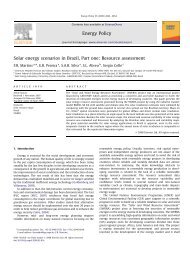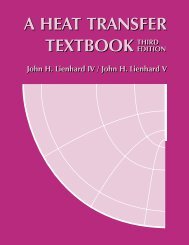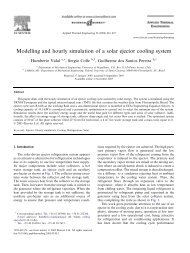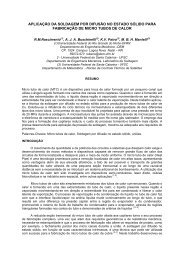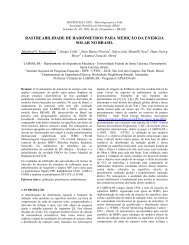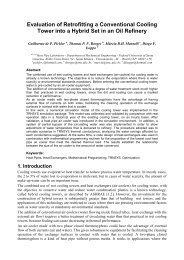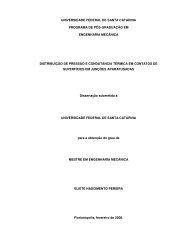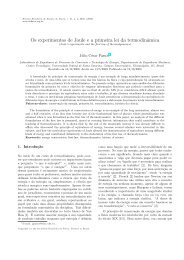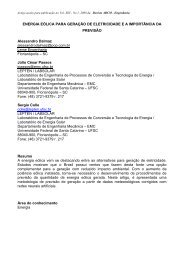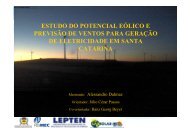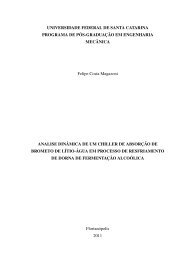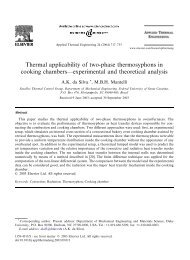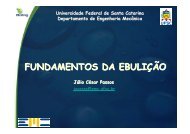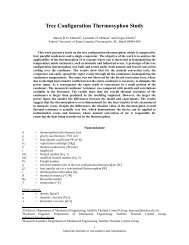Bianca Sens dos Santos - LEPTEN - Universidade Federal de Santa ...
Bianca Sens dos Santos - LEPTEN - Universidade Federal de Santa ...
Bianca Sens dos Santos - LEPTEN - Universidade Federal de Santa ...
Create successful ePaper yourself
Turn your PDF publications into a flip-book with our unique Google optimized e-Paper software.
viii<br />
ABSTRACT<br />
With technological energy reduction <strong>de</strong>velopment, different types of economic and ecological<br />
ovens, which replace the wood and electric ballast as energy sources, are being released to<br />
the market. The food industry aims for the <strong>de</strong>velopment of better quality products (ovens), as<br />
well as the establishment of more efficient and better controlled processes (cooking). The<br />
un<strong>de</strong>rstanding of the impact of these technologies in the cooking process and food quality is<br />
directly associated with their sensory properties (texture, color, flavor). Moreover, for the<br />
<strong>de</strong>sign of cooking ovens, the knowledge of some thermophysicals properties of food is<br />
nee<strong>de</strong>d. In this context, the main objective of this study is to evaluate the impact of different<br />
configurations of an oven in the quality of pizza, by setting up the best conditions for their<br />
cooking and by characterizing the predominant mechanisms of heat transfer. Therefore, it is<br />
necessary to <strong>de</strong>termine the thermal conductivity and diffusivity properties of pizza dough,<br />
during the cooking process. For this study, an oven prototype was built, consisting of a<br />
rectangular chamber (50 cm x 50 cm x 25 cm), where internal plates were in<strong>de</strong>pen<strong>de</strong>ntly<br />
temperature controlled. A fan was coupled to the top region of the oven. The impact of<br />
different oven configurations on the pizza´s quality was studied on the basis of four factors:<br />
the presence or absence of heat transferred by radiation from the surfaces of the oven,<br />
presence or absence of heat transferred by radiation from upper surface, presence or<br />
absence of forced convection and two materials, used in the oven bases (cooking tins):<br />
aluminum and stone. The quality standards evaluated for the pizza were: the edge texture,<br />
color, factor of safety in the food heating process and water loss. The temperature of the<br />
oven’s surfaces were set on 250°C and the time of c ooking at 10 minutes. The electrical fan<br />
frequency, when on, was set at 35 Hz. It was observed that the forced convection contributed<br />
heavily to the improvement of all quality parameters evaluated. The color, measured by a<br />
scale built specifically for this purpose, increased by 92% when compared to pizzas baked<br />
without forced convection. The edge texture increased by 37%, the water loss by 98% and<br />
the safety factor by 934%. Statistically, the radiation provi<strong>de</strong>d by the upper and si<strong>de</strong><br />
surfaces presented the same influence over the edge texture, water loss and safety factor.<br />
The material of the baking tin presented influence only over the safety factor, increasing it by<br />
8%. Based on these results, the following configuration was set as the best one: radiation<br />
from all surfaces, ventilation insi<strong>de</strong> the chamber and use of stone as the material of the base<br />
of the furnace, in contact with the pizza. With this configuration, three levels of the electrical<br />
fan frequency was studied: 5, 20 and 35 Hz; three levels of temperature were adopted: 150,<br />
250 and 350°C and three different cooking times w ere analyzed: 3, 5 and 10 minutes. The



